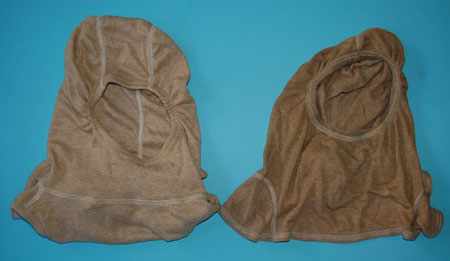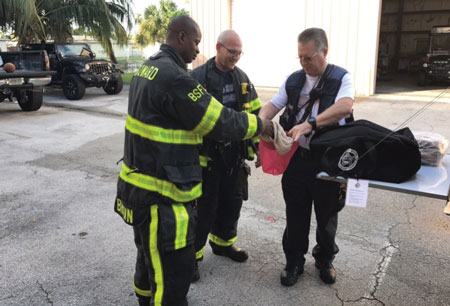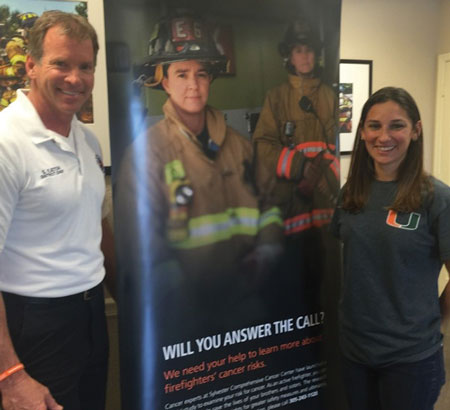
Fire Service Cancer Drives Regionwide Collaboration in Florida
By Todd J. LeDuc and Samuel A. Eaton
Broward County (FL) Sheriff’s Office Department of Fire Rescue (BCSDFR) has focused its internal efforts on reducing the preventable occupational health risks to its members, including cardiovascular and cancer risks. To that end, joint labor-management efforts have been invested in education, training, and programs aimed at addressing preventable threats to firefighters.
Cancer Awareness
The department partnered with the Fire Cancer Support Network (FCSN) and Keith Tyson, its education director, to make cancer awareness presentations to its members at 21 stations over three shifts. The presentations focused on the current science of occupational exposure and elevated rates of certain types of cancers in firefighters as well as preventable actions that firefighters and the fire service must take to curb cancer.
The presentations raised a level of awareness at a time when the department also successfully implemented physicals that are compliant with National Fire Protection Association (NFPA) 1582, Standard on Comprehensive Occupational Medical Program for Fire Departments. The examinations were supplemented with diagnostic ultrasound scanning that identified six confirmed thyroid cancers and a testicular cancer, making this a very personal issue for members of the department. Additionally, the department had lost members from cancer.
 |
| (1) The contaminated hoods sent for “destructive testing” to identify potential contaminants. (Photos 1-3 by Michael Jachles.) |
During the FCSN training, the several images from the Florescent Aerosol Screening Test (FAST), conducted by Dr. Jeffrey Stull, showed that particulate matter had penetrated through personal protective equipment (PPE) onto the skin, allowing absorption, particularly with dilated blood vessels from heat and open pores (Figure 1). This underscored the need for wipes to remove the soot and exposure particulates, especially in high-absorption areas such as the head, neck, jaw, throat, underarms, and hands immediately while still on scene.
This also promoted a discussion of how PPE is cleaned and carcinogens are removed. In particular, we elected to partner with Dr. Stull and the FCSN network to test a random sampling of our in-service hoods. Three in-service hoods were sent for “destructive testing” to determine the existence of potential contaminants.
 |
| (2) Assistant Chief Todd Leduc and BCSDFR firefighters overpacking soiled hoods for advanced testing. |
The analysis of the hoods for different types of contaminants showed the presence of several substances at significant levels. Several heavy metals were detected at levels that were higher than ordinary background levels. Contrary to our expectations, headspace analysis for volatile organic chemicals identified numerous aldehydes commonly associated with fires.
One of the laboratories that applied a more directed analysis of the hood materials for target chemicals identified semivolatile toxic or carcinogenic compounds in the used, soiled hoods. Normal practices for analyzing semivolatile organic compounds are not sufficiently sensitive for quantifying the levels of several contaminants of interest. Other than wipe sampling for metals analyses and headspace analysis for volatile organic compounds, nondestructive sampling techniques do not have adequate analytical capabilities for discerning levels of firefighter clothing contamination.
 |
| (3) The types of in-service hoods sent for laboratory analysis. |
Elevated contaminant levels of various types are clearly indicated for used, soiled firefighter protective hoods that have been exposed in structural fires. Among these contaminants are known skin toxic and carcinogenic compounds. Given the proximity of the hood to the firefighter’s skin, especially on an area of the body that permits relatively rapid skin permeation, the continued use of contaminated hoods represents an exposure hazard and could contribute to chronic health issues. It was, therefore, recommended that firefighter hoods be removed following each structural fire and adequately cleaned before the next use.
Actions
The results of our hood-sampling analysis led to changes with PPE and personnel accountability actions. Internal messaging at each station focused on gross decontamination of PPE to remove as much contamination as possible. Full self-contained breathing apparatus (SCBA) now must be worn during all phases of initial attack through overhaul.
 |
| (4) Battalion Chief James Quinn and his crews demonstrating the hood exchange program and “hazardous overpacking” of contaminated hoods before being sent for advanced cleaning. (Photo by Todd Leduc.) |
With regard to actions related to hood contamination, Broward County instituted a “hood exchange” program through its battalion chiefs. Each battalion unit is assigned a cache of clean hoods. After any exposure to potential contaminants, the battalion chiefs collect all exposed hoods in contamination containment bags. The hoods are sent out for advanced cleaning with an independent service provider (ISP), and the crews are issued fresh hoods. This allows for accountability in that all hoods were washed in advance and members are issued clean hoods at the point of contact.
Additionally, as part of a “Firefighter Protective Hood Replacement and Carcinogen Mitigation Strategies” standard operating guideline (SOG), firefighters had been provided with body cleansing wipes to immediately decontaminate skin and areas of high absorption on the scene prior to showering. Messaging within each fire station also played an important role in reinforcing cultural expectations and served as a reminder of these expectations and accountability at each house.
The Firefighter Cancer Initiative – Sylvester Comprehensive Cancer Center at UM
During approximately this same period, with an inception date of January 2014, a specialized firefighter cancer prevention team formed within Palm Beach County Fire Rescue (PBCFR), a sizeable fire department organization that serves a population close to 900,000 through 49 fire stations and approximately 1,500 operations personnel. This team, named FACE (Firefighters Attacking the Cancer Epidemic), was formed because of growing concerns about the number of personnel who had been diagnosed with cancer.
By the end of the year, through a strong connection with the Florida chapter of the FCSN, a partnership had developed between Sylvester Comprehensive Cancer Center (SCCC) at the University of Miami and PBCFR’s FACE Team. This newly formed alliance was the beginning of a later, much larger collaboration and research initiative between SCCC and the Florida fire service. Through the support of a state of Florida appropriation, the Firefighter Cancer Initiative (FCI) was launched in 2015 to study firefighters’ exposure to carcinogens; their risks for developing cancer; and methods of education for prevention, screening, and early detection. Since then, researchers have been working closely with PBCFR, Miami-Dade Fire Rescue, and BCSDFR and branching into additional fire departments on various projects to learn more about these critical issues and to identify improved measures to reduce risk. The research team managing the expanding study includes faculty and staff from SCCC and the University of Miami Miller School of Medicine, School of Communication, and School of Education and Human Development.
![(5) Some of the equipment used in Palm Beach County (FL) Fire Rescue’s On-Scene Post-Fire Decon Procedure. [<i>Photos courtesy of Palm Beach County (FL) Fire Rescue.] </i>](https://emberly.fireengineering.com/wp-content/uploads/2017/06/1706Fe_LeDucPhoto5.jpg) |
| (5) Some of the equipment used in Palm Beach County (FL) Fire Rescue’s On-Scene Post-Fire Decon Procedure. [Photos courtesy of Palm Beach County (FL) Fire Rescue.] |
In its first year, more than 1,600 active firefighters throughout South Florida’s tri-county area completed the FCI’s annual cancer survey, a comprehensive questionnaire collecting medical/cancer history and occupational risk factors related to firefighters. Firefighters were also engaged in cervical and colorectal cancer screening, environmental sampling projects, and an educational campaign to increase awareness about prevention and early detection.
Now in its second year, the FCI is expanding its scope to include additional projects, such as a longitudinal study focused on retired firefighters and the study of a wellness program for improving measures of fitness, health, and cancer risks. The project will also be expanding to include additional fire departments throughout the state of Florida.
The very first Florida firefighter surveyed and studied under the FCI initiative was a PBCFR firefighter in December 2015. As PBCFR’s FACE Team broke ground with this world-renowned research institute, they (along with the SCCC) quickly realized that fostering relationships with as many fire departments as possible was needed to create the level of cultural shift necessary to have the intended impact, to identify the very best prevention practices available, and to strengthen and deepen the study and the initiative’s impact.
![(6) Some of the equipment used in Palm Beach County (FL) Fire Rescue’s On-Scene Post-Fire Decon Procedure. [<i>Photos courtesy of Palm Beach County (FL) Fire Rescue.] </i>](https://emberly.fireengineering.com/wp-content/uploads/2017/06/1706FE_LeDucPhoto6.jpg) |
| (6) Some of the equipment used in Palm Beach County (FL) Fire Rescue’s On-Scene Post-Fire Decon Procedure. [Photos courtesy of Palm Beach County (FL) Fire Rescue.] |
Much like Broward, on the preventive side, a few of PBCFR’s FACE Teams’ early advancements have been noted, including their departments’ implementing a mandatory on-scene Hood Swap program that’s managed directly by their operations battalion chiefs after every fire. Also, they guided the departments’ facilities divisions in changing heating, ventilation, and air-conditioning systems in all their fire stations to a positive-pressure mode, minimizing/eliminating cross-transfer of emissions into the living quarters. More recently, they implemented a pilot program in two battalions to work through an on-scene postfire decontamination process. This process concentrates on cleaning PPE from the moment the firefighter leaves the immediately dangerous to life or health environment with just as much emphasis on the firefighters beginning personal skin wiping and decontamination on scene, which is then continued back at the station. That pilot program led to a final SOG and training program with a departmentwide launch by the end of 2016.
From the research side, PBCFR worked directly with SCCC’s Communications Team to conduct an organization culture study for eight months. This was followed by some battalions being used to pilot test the Cultural Training Program that SCCC plans to roll out to other fire departments in the region and state. These pilot sessions helped to refine the training program. The developed tools and excellent media are designed to help our firefighters truly see the dangerous effects of some traditional firefighting work practices and how they can have a negative impact on health and longevity. Videos depicting the ease with which carcinogen particulate transfers from the fire scene back to the firehouse shown during the training proved effective in shifting the mindset in the pilot runs of the training program. Photo 7 shows one of the training and culture tools produced by SCCC’s Communications Department. SCCC’s intention is to complete the training program and formalize and deliver it throughout the state, beginning in the South Florida Region.
 |
| (7) PBC Firefighter Health Dr. Natasha Schaefer Solle, Sylvester Comprehensive Cancer Center, and Samuel A. Eaton, PBCFR battalion chief, when the new displays were delivered. (Photo courtesy of Tara Cardoso, public relations specialist, FFSHC FACE.) |
Also unique to PBCFR and the FCI is the connection with the Palm Beach County Benefits Fund Health & Wellness Center, where through the cooperation of the medical director and its administration, SCCC was able to “set up shop” and run the voluntary Firefighter Cancer Survey with all willing personnel, welcoming firefighters to “Answer the Call” to participate. Working directly with the professional clinic staff allowed SCCC to efficiently implement blood draws in sync with each firefighter’s annual physical, adding the all-important voluntary biological sampling to improve the process and enrich the data collected.
As the research continues to evolve on this topic, no doubt we will continue to enhance our exposure-mitigation efforts. The Research Fire Protection Foundation has commissioned a study entitled “How Clean Is Clean?” aimed at continuing to improve our knowledge based on addressing contaminated PPE. The South Florida fire service will continue to strengthen its collaborative efforts internally and externally with the SCCC at the University of Miami as well as the national nonprofit organization FCSN.
Endnote
1. Florida’s State FACE Team was formed in November 2016 under the Florida Firefighters Safety and Health Collaborative (FFSHC). Now supported by the Florida Fire Chief’s Association, the State Fire College, and many other leading state organizations, the mission of the FFSHC 12-department FACE team + the FCSN – Florida Chapter is to collaboratively develop state prevention recommendations aimed at addressing the many components that are leading to carcinogen exposure to fire service personnel.
TODD J. LEDUC, MS, CFO, CEM, FIFirE, is a 27-year veteran of the Broward County (FL) fire service and assistant chief of the internationally accredited 750-member department. He is the secretary of the International Association of Fire Chief’s Association Safety, Health & Survival Section and a peer reviewer for professional credentialing and agency accreditation with the Center for Public Safety Excellence. He is a member of the Regional FACE Team that includes 11-plus fire departments from Jacksonville to Miami-Dade.
SAMUEL A. EATON is a 26-year veteran firefighter for Palm Beach County (FL) Fire Rescue. He is an operations battalion chief, has been a command officer for 16 years, and is the co-chair of the Firefighters Attacking the Cancer Epidemic (FACE) Team that has been a significant factor in driving change in the South Florida fire service relative to the occupational cancer risk. He is a co-director of the State FACE Team that includes the Firefighter Cancer Support Network – Florida Chapter and 12 fire departments from Jacksonville to Miami-Dade.
“I Was Granted That 14% Miracle”
Following is a letter from Firefighter Christopher Thompson of Fire Rescue District 6, Port Everglades, Florida, to the Broward Sheriff’s Office Administration expressing his and his family’s gratitude for the opportunity to participate in the “Life Scan” program that diagnosed a “rare variation of thyroid cancer.”
March 2016
To B.S.O. Administration &
Division Chief Leduc
On behalf of my wife, 11-month-old daughter, and myself, we wanted to convey our thanks to you, the administration, for the proactive initiative in bringing the “Life Scan” grant to us. As you may know, they found some nodules that raised suspicion, and I went for further testing and biopsies from my medical doctors. As it turns out, I got a phone call from my endocrinologist, and he said, “I don’t know why you had an ultrasound done, but thank your lucky stars.”

They found two types of rare cancers in their early stages from the nodules discovered by the “Life Scan” folks. The cancer diagnosis I received was a rare variation of thyroid cancer that has no warning symptoms and another small tumor that is known to be aggressive. Statistically, by the time it’s found is when the body is symptomatic because the cancer has spread and is affecting other organs and tissues. Then, after metastasis, there is 74% mortality in the first five years, and of those who survive, there is 79% mortality within 10 years. Chemo and radiation do not work with this type of cancer; thus, it is considered terminal in most cases when metastasized.
The Biomarker blood test for my cancer was at 147 cal. At 150, spread is known to start to occur. The surgery was January 25, removing my total thyroid, all the central lymph nodes, and one para thyroid. The pathology came back for the actual sizes of the two tumors found in the thyroid. The real nasty one was at 9mm. It is known to start to spread at 10mm. The other was a follicular type at only 2mm and typically starts to spread at 5mm. Most remarkably, all central lymph nodes were removed as a precaution and found to be clear of cancer and both tumors were “organ confined” to the thyroid that had been removed and did not spread. Statistically, 86% of cases see at least regional spread to the local lymph nodes. I had no spread, and that was the 14% chance we were praying for. By God’s grace and BSO’s proactive early scanning with “Life Scan,” I was granted that 14% miracle, and there is a very good chance I may even be cured! Thank you, and God bless you all and your families.
Best Regards,
Chris, Pam, and Chloe Thompson
Why Cancer Is Killing Boston’s Firefighters
West Chester (OH) Firefighter Dies of Occupational Cancer
Veteran California Firefighter Dies of Cancer
Cancer Schmancer… Can We Please Talk About Something Else?
Fire Engineering Archives

